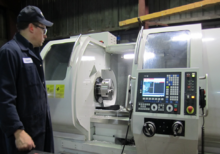Our website is made possible by displaying online advertisements to our visitors.
Please consider supporting us by disabling your ad blocker.
Machining


Machining is a manufacturing process where a desired shape or part is created using the controlled removal of material, most often metal, from a larger piece of raw material by cutting. Machining is a form of subtractive manufacturing,[1] which utilizes machine tools, in contrast to additive manufacturing (e.g. 3D printing), which uses controlled addition of material.
Machining is a major process of the manufacture of many metal products, but it can also be used on other materials such as wood, plastic, ceramic, and composites.[2] A person who specializes in machining is called a machinist. As a commercial venture, machining is generally performed in a machine shop, which consists of one or more workrooms containing primary machine tools. Although a machine shop can be a standalone operation, many businesses maintain internal machine shops or tool rooms that support their specialized needs. Much modern-day machining uses computer numerical control (CNC), in which computers control the movement and operation of mills, lathes, and other cutting machines.
- ^ "MAS.863/4.140J-P7". Fab Central. Massachusetts Institute of Technology. Retrieved 2016-08-22.
- ^ "Machining Page". CYBERMAN. John W. Sutherland's Research Page. Archived from the original on 2018-09-08. Retrieved 2011-10-05.
Previous Page Next Page


